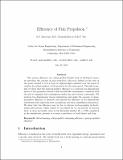Efficiency of fish propulsion
Author(s)
Maertens, Audrey; Triantafyllou, Michael S; Yue, Dick K. P.
DownloadMaertens 2015 - Efficiency of Fish Propulsion.pdf (608.9Kb)
OPEN_ACCESS_POLICY
Open Access Policy
Creative Commons Attribution-Noncommercial-Share Alike
Terms of use
Metadata
Show full item recordAbstract
The system efficiency of a self-propelled flexible body is ill-defined, hence we introduce the concept of quasi-propulsive efficiency, defined as the ratio of the power needed to tow a body in rigid-straight condition over the power it requires for self-propulsion, both measured for the same speed. Through examples we show that the quasi-propulsive efficiency is a rational non-dimensional metric of the propulsive fitness of fish and fish-like mechanisms, consistent with the goal to minimize fuel consumption under size and velocity constraints. We perform two-dimensional viscous simulations and apply the concept of quasi-propulsive efficiency to illustrate and discuss the efficiency of two-dimensional undulating foils employing first carangiform and then anguilliform kinematics. We show that low efficiency may be due to adverse body-propulsor hydrodynamic interactions, which cannot be accounted for by an increase in friction drag, as done previously, since at the Reynolds number Re = 5 000 considered in the simulations, pressure is a major contributor to both thrust and drag.
Date issued
2015-07Department
Massachusetts Institute of Technology. Department of Mechanical Engineering; Massachusetts Institute of Technology. Department of Ocean EngineeringJournal
Bioinspiration & Biomimetics
Publisher
IOP Publishing
Citation
Maertens, A P; Triantafyllou, M S and Yue, D K P. “Efficiency of Fish Propulsion.” Bioinspiration & Biomimetics 10, 4 (July 2015): 046013 © 2015 IOP Publishing Ltd
Version: Author's final manuscript
ISSN
1748-3190
1748-3182